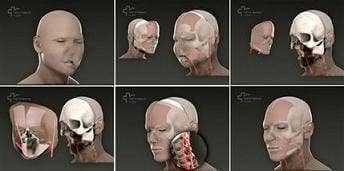Latest Face Transplant in Spain Most Extensive Ever (Video)

Share
A team of surgeons in Spain have completed what they call the first "full face" transplant. An unnamed man who lost most of his face in an accident was given the skin, muscles, nose, lips, palate, teeth, cheekbones and the jaw of a donor. Remarkably, the patient will only have one visible scar - an undulating line around his neck. The operation took more than 24 hours and the work of 30 doctors at Vall d'Hebron Hospital in Barcelona at the end of March this year. This is only the 11th face transplant in the world, and the most complicated such procedure to date. While there are still many risks to replacing someone's face, this surgery demonstrates that more and more of the human body is repairable, reusable, and replaceable. Which is great news for those of us looking to live longer and healthier. Watch a short virtual explanation of the operation along with comments from head surgeon Joan Pere Barret in the video below.
What's keeping you from living forever? In short, your body and accidents. While there are organizations looking to extend the lifespan of your cells, such research will not provide the means to overcome grave injury or illness. We may one day find the formula for keeping you young and healthy well past the century mark, but that won't help you if you are hit by a bus. Or shot in the face. Which is exactly the way that the young man in Spain was injured. It's truly amazing that a gunshot wound to the face can be repaired, however risky and tentative the procedure may be now. Given a long enough lifespan we all might encounter such horrendous and damaging accidents. If we want to truly live forever miraculous surgeries such as this one may be as important as the research into our cells and our genetics.
While the surgery replaced a huge portion of the patient's face it's uncertain how accurate the "full face transplant" label really is. The entire residual bone, skin, and muscle mass below the eyes was cut off and replaced by the donor tissue. That's amazingly impressive and goes beyond previous attempts made around the world. However, as ABC News points out, there are some who question whether eye lids, eye sockets, etc. would also need to be completely replaced for this to qualify as a full face transplant. Perhaps this is just a problem with labels. Whether or not this is a "full face" or "nearly full face" transplant doesn't matter much to me. The Spanish team replaced more of a face than anyone has previously. It's progress and that's what is important.
Be Part of the Future
Sign up to receive top stories about groundbreaking technologies and visionary thinkers from SingularityHub.


This is still an extremely risky surgery and the body could still reject the donor tissue years after it is completed. Of the 11 patients who have undergone similar procedures at least two have died due to complications. Still, considering the drastic quality of life changes brought on by the operation, I understand why the patient's choose to take that risk. As immunosupressant medication improves we may see this danger decrease. Conceivably, the possibility of rejection could be removed altogether by developing the means to grow a new face from the patient's own stem cells in the same manner that we've seen with internal organs recently. Considering the complexity of the face, and the various tissues types involved, it would likely be many years before such techniques could be developed, but I wouldn't be surprised if they were somewhere nearby on the horizon.
I find it interesting that the lead surgeon, as well as most major media outlets, make a pronounced effort to explain to the public that the recipient will not look like the face-donor. Is the public perception that we are close to being able to steal someone's physical appearance? Did everyone get spooked by Face-Off? Many years from now we may have the means to reconstruct someone's bone structure to exactly replicate someone else's skull, but that's a ways off yet. It's a little strange that face-snatching seems more relevant than simply accepting how incredibly miraculous it is that someone can have their face blown off with a gun and then have another attached years later.
But such medical miracles have become almost common place now, and more are waiting in the pipeline. We've already seen surgical robots, tissue regeneration, stem cell organ transplants, and organ printing. Who knows what kind of incredible operations could be accomplished as these technologies are perfected and made to work together. While we search for the means to keep our cells living for as long as possible, it seems that surgeons will continue to find ways of patching us back together after we have accidents. Such cutting and sewing may seem less eloquent than the simple injections of stem cells, or applications of gene therapy, but they are a necessary and marvelous part of medicine. Look for more face transplants in the months and years ahead.
[image credit: AP and Vall d'Hebron Hospital]
[video credit: Al Jazeera English News]
[source: ABC News, BBC News, AP]
Related Articles

Single Injection Transforms the Immune System Into a Cancer-Killing Machine

This Light-Powered AI Chip Is 100x Faster Than a Top Nvidia GPU

This Week’s Awesome Tech Stories From Around the Web (Through December 20)
What we’re reading
